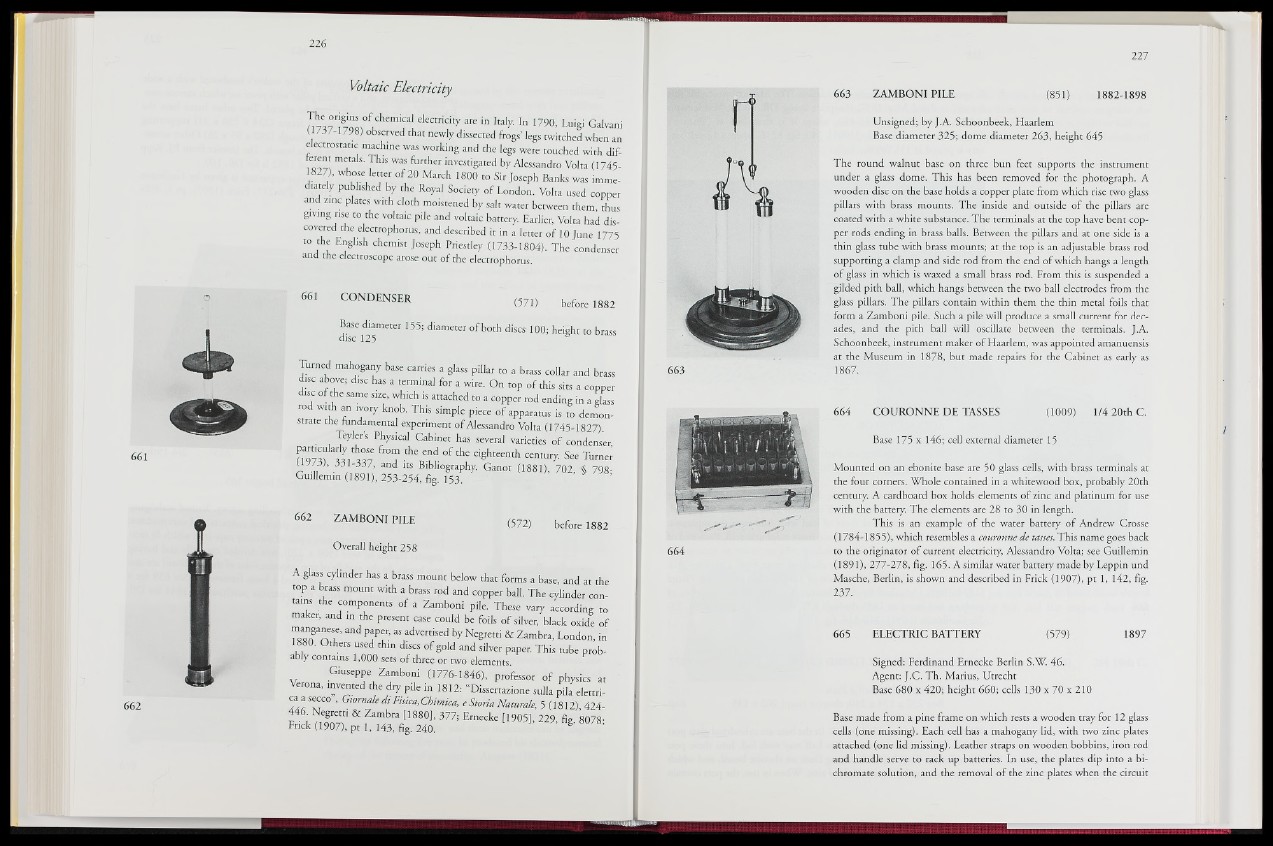
Voltaic Electricity
■ ■ ■ ¡ ■ i I in My- In 1790, Luigi Galvani
IB. I observed that newly dissected frogs’ legs twitched when an
electrostatic machine was working and the legs were touched with dif-
me. J hls was M ther investigated by Alessandro Volta (1745-
1827), whose letter of 20 March 1800 to Sir Joseph Banks was immediately
published by the Royal Society of London. Volta used copper
and zinc plates with cloth moistened by salt water between them, thus
giving rise to the voltaic pile and voltaic battery. Earlier, Volta had discovered
the electrophorus, and described it in a letter of 10 June 1775
to the English chemist Joseph Priestley (1733-1804). The condenser
and the electroscope arose out of the electrophorus.
661 CONDENSER (571) before 1882
661
Base diameter 155; diameter of both discs 100; height to brass
disc 125
Turned mahogany base carries a glass pillar to a brass collar and brass
disc above; disc has a terminal for a wire. On top of this sits a copper
disc of the same size, which is attached to a copper rod ending in a glass
rod with an ivory knob. This simple piece of apparatus fgto demonstrate
the fundamental experiment of Alessandro Volta (.1745-182*
• i ^ eylfrs Ph7slcal Cabinet has several varieties of Sondenser
B B S T I end °f I eiShteeMb century. See Turner
H I H 331-337, and its Bibliography. Ganot (1881), 702, §: 798-
Guillemin (1891), 253-254, fig. 153.
662 ZAMBONI PILE (572) before 1882
Overall height 258
A.g|ass cylinder has a brass mount below that forms abase, and at the
top a brass mount with a brass rod and copper ball. The cylinder ¡fn -
tains the components of a Zamboni pile. These v a r y K & o
maker, and m the present case could feV foils of silver, black oxide of
111(1 H “ advertised b7 NeS«tti & Zambra, London, in
880. Others used thin discs of gold andll#ii%aper. This tube prob-
ably contains 1,000 sets of three or two elements.
Giuseppe Zamboni (1*76-1846), professor of physics at
Verona, invented the dry pile in 1812: “Dissertazione sulla pila elettri-
ca aseceo;, GiomalediFism,Chimica, eStoriaNaturale, 5 ( l8 l2 ) i |a L
446 Negretti & Zambra 1880.V-377; Ernecke [19051V 229, fig 8078-
Frick (1907), pt 1, 143, fig. 240.
663 ZAMBONI PILE (851) 1882-1898
Unsigned; byJ.A. Schoonbeek, Haarlem
Base diameter 325; dome diameter 263, height 645
The round walnut base on three bun feet supports the instrument
under a glass dome. This, has been removed for the photograph. A
wooden disc on the base holds a copper plate from which rise two glass
pillars with brass mounts. The inside and outside of the pillars are
coated with a white substance. The terminals at the top have bent copper
rods ending in brass balls. Between the pillars and at one side is a
thin glass tube with brass mounts; at the top is an adjustable brass rod
supporting a clamp and side rod from the end of which hangs a length
of glass in which is waxed a small brass rod. Prom this is suspended a
glided pith;bal!, which hangs between the two ball electrodes from the
glass pillars. The pillars contain within them the thin metal foils that
form a Zamboni pile. Such a pile will produce a small current for decades,
and the p^g^HLgwill oscillate between the terminals. J.A.
Schoonbeek, instrument maker of Haarlem, was appointed amanuensis
at the Museum in 1878, but made repairs for the Cabinet as early as
1 8 6 ^ |
664 COURONNE DE TASSES (1009) 1/4 20th C.
BaseVlVS' x 146:pj l external d iam e te r» ;';' -
Mounted on an ebonite) base are 50 glass cells, with brass terminals at
the four corners. Whole contained in a whitewood box, probably 20th
century. A cardboard box holds elements of zinc and platinum for use
with®te batrery. The elements are 28 to 30 in length.
This is an example of the water battery of Andrew Crosse
(1784-1855), which resembles a couronne de tosses. This name goes back
to the originator of current electricity, Alessandro Volta; see Guillemin
i|§891), 27$jp78, fig. 165. A similar water battery made by Leppih und
-Maschi:, BerliS isftown anddescribed in Frick (1907), pr 1, 142, fig.
665 ELECTRIC BATTERY # 7 9 ) 1897
Signed: Ferdinand Ernecke Berlin S.W. 46.
Agent: J.C. Th. Marius, Utrecht
Base 680 x 420; height 660; cells 130 x 70 x 210
Base made from a pine frame on which rests a wooden tray for 12 glass
cells-(one missing). Each cell has a mahogany lid,- with two zinc plates
attached (one lid missing). Leather straps on wooden bobbins, iron rod
and handle serve to rack up batteries. In use, the plates dip into a bichromate
solution, and the removal of the zinc plates when the circuit